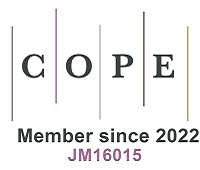Structure, magnetism and low thermal expansion in Tb1-xErxCo2Mny intermetallic compounds
Abstract
Here, we obtained a series of controllable thermal expansion alloys Tb1-xErxCo2Mny (x = 0-0.5, y = 0-0.4) by incorporating double rare earth doping and introducing non-stoichiometric Mn content. By varying the amount of Er or Mn, a low thermal expansion (LTE) is achieved in Tb0.6Er0.4Co2Mn0.1 (TECM, α1 = 1.23 × 10-6 K-1, 125~236 K). The macroscopic linear expansion and magnetic properties reveal that anomalous thermal expansion is closely related to the magnetic phase transition. Synchrotron X-ray powder diffraction results show that TECM is a cubic phase (space group: Fd-3m) at high temperatures, and a structural transition to a rhombohedral phase
Keywords
INTRODUCTION
By flexibly compensating for thermal expansion, negative thermal expansion (NTE) materials have gained significant attention and development over the past three decades. The NTE is an important requirement for the development of zero thermal expansion (ZTE) materials, which exhibit no dimensional changes when subjected to heating. Materials with a coefficient of thermal expansion below 2 × 10-6 K-1 are defined as low thermal expansion (LTE) materials and find applications in various engineering environments, such as electronic devices, optical instruments, and spacecraft. An example is Invar alloy Fe0.65Ni0.35, which has been extensively used since its discovery in 1897[1]. Over time, other LTE alloys such as Fe-Co-Cr stainless steel Invar alloys and other alloy compositions have emerged[2]. In comparison with oxides[3], fluorides[4], and cyanides[5], LTE alloys offer additional properties such as optical properties[6], excellent electrical, thermal transport properties, and mechanical properties[7-9]. Examples of such alloys include (Zr, Nb)Fe2[10,11],
Cubic Laves phase RECo2 has been studied intensively due to its relatively simple crystal and magnetic structures. It belongs to a class of materials known for their magnetostrictive and magnetocaloric properties[23]. The compound is composed of two magnetic sublattices: one involving the local magnetic moment of REs, and the other comprising the Co sublattice, which exhibits long-range magnetic ordering induced by the molecular field of RE atoms[24,25]. In previous literature, samples TbCo2Mny (y = 0, 0.1, 0.2, and 0.3) were found to exhibit a rhombohedral structure (space group: R-3m) below the Curie temperature (TC) and undergo a transition to a cubic structure (space group: Fd-3m) above TC[26]. TbCo2Mny were reported for the ZTE temperature window of about 40 K[23]. Intriguingly, the introduction of the element Er in compound TbCo2Mny gives the Laves phase of Tb1-xErxCo2Mny, and their ZTE temperature windows can be wider with increasing Er content. In the (RE1-xRE'x)(Co1-yMy)2 compounds, the substitution of the RE' atoms for the RE atoms occurs only in the 16d atomic site, while the substitution of the M atoms for Co atoms takes place in the 8a site[24]. This differs from the (RE1-xRE'x)Co2Mny compounds, where the Mn atoms can replace the 8a and 16d sites in the cubic structure with equal probability[27]. This unusual modulation of multiple sites in (RE1-xRE'x)Co2Mny compounds significantly increases the TC of the corresponding Mn-free compounds. In this study, new intermetallic compounds Tb1-xErxCo2Mny (x = 0, 0.1, 0.2, 0.4, and 0.5, y = 0 and 0.1), with a MgCu2 type cubic structure, are introduced. These compounds can be modulated by changing their components to achieve near ZTE.
MATERIALS AND METHODS
All the Laves-phase samples of Tb1-xErxCo2Mny (x = 0, 0.1, 0.2, 0.4, and 0.5, y = 0 and 0.1) were prepared by arc melting under high-purity argon environment using raw materials with a purity of more than 99.9%, which were weighed at the designed ratio of raw materials. To ensure homogeneity, the samples were turned over and melted more than three times. At the end of the arc melting, the ingots are wrapped with molybdenum foil and annealed in a vacuum-sealed quartz tube at 1,173 K for one week. The purity of the samples was verified by a laboratory X-ray diffractometer (XRD, PANalytical X’Pert PRO) with Cu Kα radiation. The scanning electron microscopy (SEM) imaging and X-ray energy dispersive spectroscopy (EDS) elemental analysis were performed using a scanning electron microscope system (1,720, EPMA, Shimadzu). All linear thermal expansion curves (ΔL/L0) were measured at a thermodilatometer (NETZSCH DIL402) with a heating rate of 5 K/min. The magnetic properties were measured by a Physical Property Measurement System (PPMS, Quantum Design company). Temperature dependence of the synchrotron
RESULTS AND DISCUSSION
Tb1-xErxCo2Mny (x = 0, 0.1, 0.2, 0.4, and 0.5, y = 0, 0.1, 0.2, 0.3) were confirmed to be pure phases by XRD at room temperature (except y = 0.4). For example, at 300 K, the Rietveld refinement of the SXRD data for Tb0.6Er0.4Co2Mn0.1 (denoted as TECM) shows the cubic structure in Supplementary Figure 1. In Tb1-xErxCo2
Figure 1. XRD patterns of the (A) Tb1-xErxCo2 (x = 0, 0.1, 0.2, 0.4, and 0.5) and (C) Tb1-xErxCo2Mn0.1 (x = 0, 0.1, 0.2, 0.4, and 0.5). The corresponding enlarged diffraction peaks (220) are (B and D). The rhombohedral (E) and cubic (F) crystal structures of RECo2
As shown in Figure 2, the samples Tb1-xErxCo2Mny (x = 0, 0.1, 0.2, 0.4, and 0.5, y = 0 and 0.1) exhibit a significantly different linear thermal expansion behavior. The NTE behavior of TbCo2 occurs in a narrow temperature window. Interestingly, the anomalous thermal expansion of the Tb1-xErxCo2
Figure 2. Linear thermal expansion (ΔL/L0) of (A) Tb1-xErxCo2 (x = 0, 0.1, 0.2, 0.4, and 0.5) and (B) Tb1-xErxCo2Mn0.1 (x = 0, 0.1, 0.2, 0.4, and 0.5).
The magnetic phase transition of TbCo2 was documented to be first-order, while that of the TbCo2Mnx compound obtained by the addition of Mn was second-order[23]. The addition of Mn significantly increased the TC of the compounds, for example, from 225 K for TbCo2 to 347 K for TbCo2Mn0.4[29]. The macroscopic FM behavior of Tb1-xErxCo2Mny (x = 0, 0.1, 0.2, 0.4, and 0.5, y = 0 and 0.1) was determined by measurements of zero-field cooling (ZFC) and field cooling (FC) during heating in a 500 Oe magnetic field
Figure 3. Temperature dependence of ZFC for the (A) Tb1-xErxCo2 and (B) Tb1-xErxCo2Mn0.1 compounds under an applied magnetic field of 500 Oe from 5 to 380 K. FC-ZFC and the derivative curves of FC/ZFC of (C) TEC and (D) TECM compounds, respectively. (E) Curie temperature for Tb1-xErxCo2Mny (the results are obtained from the derivative curves of FC/ZFC). (F) Isothermal M-H curves (-4 to 4 T) for TECM.
In the SXRD intensity contour plot of the TECM compound [Figure 4A], a splitting of the peak at low temperatures near 20.85° was found. The crystal structure of TECM was determined by SXRD, and it was demonstrated that it produces a phase transition from cubic (Fd-3m space group) to rhombohedral (R-3m space group) with decreasing temperature. Rietveld refinement results of TECM at T = 100 K and T = 275 K are shown in Figure 4B. By a refinement of the SXRD pattern, this transition can be described in the inset of Figure 4B. The results show that the two peaks (110) and (104) of the rhombohedral structure are replaced by the peak (220) of the cubic structure. The temperature dependence of the unit lattice parameters and volume of TECM from 100 K to 325 K is shown in Figure 4C. From the correlation between the unit cell of the rhombohedral model (space group: R-3m) and the cubic model (space group: Fd-3m), it is clear that the amounts of
Figure 4. (A) Contour plot of the SXRD intensity for TECM compound. (B) Full profile Rietveld refinements of the SXRD patterns for the TECM compound at 100 K and 275 K. (The illustration shows the enlarged area. The experimental profiles are shown by star markers. Bragg reflections are indicated by ticks. Pink lines represent the calculated data, while black lines represent the difference between the observed and calculated data.) (C) Temperature dependence of the lattice parameters a, c, and V of TECM measured by SXRD. (The amounts of
CONCLUSIONS
In summary, a series of Tb1-xErxCo2Mny intermetallic compounds with a cubic MgCu2-type structure were synthesized. The addition of Mn increases the TC and contributes to a low thermal expansion with a wide temperature window. It has been confirmed by the high-resolution SXRD, which signifies such LTE is attributed to magnetic-structural transition below TC. The TECM compound shows a cubic (Fd-3m) structure above TC while transforming to rhomboidal (R-3m) below TC. TECM has a wide temperature window of the low thermal expansion curves, which offers good prospects for both basic research and applications. This work provides structural information and near ZTE properties of the compounds
DECLARATIONS
Authors’ contributionsConceived and designed the study: Xing X
Prepared the samples and collected the data: Sun Y
Performed data analysis and wrote the main draft of the paper: Sun Y, Cao Y, Xing X
Analyzed the thermal expansion results: Li Q, Deng J, Miao J, Lin K
Conducted the SXRD measurements: Ren Y, Lapidus SH
All authors discussed the results and commented on the manuscript.
Availability of data and materialsNot applicable.
Financial support and sponsorshipThis work was supported by the National Key R&D Program of China (2020YFA0406202), the National Natural Science Foundation of China (22275015, 22090042, 21971009, and 21731001), and the Fundamental Research Funds for the Central Universities, China (FRF-IDRY-19-018 and FRF-BR-19-003B). This research used resources of the Advanced Photon Source, a U.S. Department of Energy (DOE) Office of Science User Facility operated for the DOE Office of Science by Argonne National Laboratory.
Conflicts of interestAll authors declared that there are no conflicts of interest.
Ethical approval and consent to participateNot applicable.
Consent for publicationNot applicable.
Copyright© The Author(s) 2023.
Supplementary MaterialsREFERENCES
3. Huang Q, Santoro A, Lynn JW, et al. Structure and magnetic order in La1-
4. Li Q, Lin K, Liu Z, et al. Chemical diversity for tailoring negative thermal expansion. Chem Rev 2022;122:8438-86.
5. Chippindale AM, Hibble SJ, Bilbé EJ, et al. Mixed copper, silver, and gold cyanides, (
6. Poornaprakash B, Subramanyam K, Vattikuti SP, Pratap Reddy MS. Achieving enhanced ferromagnetism in ZnTbO nanoparticles through Cu co-doping. Ceram Int 2019;45:16347-52.
7. Tan Z, Miao P, Hagihala M, et al. Room temperature zero thermal expansion in a cubic cobaltite. J Phys Chem Lett 2020;11:6785-90.
8. Guo X, Ni X, Li J, et al. Designing mechanical metamaterials with kirigami-inspired, hierarchical constructions for giant positive and negative thermal expansion. Adv Mater 2021;33:e2004919.
9. Xu J, Wang Z, Huang H, et al. Significant zero thermal expansion via enhanced magnetoelastic coupling in kagome magnets. Adv Mater 2023;35:e2208635.
10. Song Y, Sun Q, Yokoyama T, et al. Transforming thermal expansion from positive to negative: the case of cubic magnetic compounds of (Zr,Nb)Fe2. J Phys Chem Lett 2020;11:1954-61.
11. Shiga M, Nakamura Y. Magnetovolume effects and invar characters of (Zr1
12. Wada H, Shimamura N, Shiga M. Thermal and transport properties of Sc1
13. Ren Q, Hutchison W, Wang J, et al. Negative thermal expansion of Ni-doped MnCoGe at room-temperature magnetic tuning. ACS Appl Mater Interfaces 2019;11:17531-8.
14. Shen F, Zhou H, Hu F, et al. Cone-spiral magnetic ordering dominated lattice distortion and giant negative thermal expansion in Fe-doped MnNiGe compounds. Mater Horizons 2020;7:804-10.
15. Hu F, Shen B, Sun J, Cheng Z, Rao G, Zhang X. Influence of negative lattice expansion and metamagnetic transition on magnetic entropy change in the compound LaFe11.4Si1.6. Appl Phys Lett 2001;78:3675-7.
16. Fujita A, Fukamichi K, Wang J, Kawazoe Y. Large magnetovolume effects and band structure of itinerant-electron metamagnetic La(Fe
17. Khmelevskyi S, Mohn P. Theory of invar anomalies in the laves phase
18. Hu J, Lin K, Cao Y, et al. Adjustable magnetic phase transition inducing unusual zero thermal expansion in Cubic
19. Yang N, Dennis K, Mccallum R, Kramer M, Zhang Y, Lee P. Spontaneous magnetostriction in
20. Kuchin A, Medvedeva I, Gaviko V, Kazantsev V. Magnetovolume properties of Y2Fe17
21. Cao Y, Lin K, Khmelevskyi S, et al. Ultrawide temperature range super-invar behavior of
23. Fang C, Wang J, Hong F, et al. Tuning the magnetic and structural transitions in TbCo2Mn
24. Bloch D, Lemaire R. Metallic alloys and exchange-enhanced paramagnetism. application to rare-earth-cobalt alloys. Phys Rev B 1970;2:2648-50.
25. Duc NH, Goto T. Handbook on the physics and chemistry of rare earths. Amsterdam: Elsevier B.V.; 1999. pp. 1-413.
26. Inishev AA, Gerasimov EG, Mushnikov NV, Terent’ev PB, Gaviko VS. Structure, magnetic and magnetocaloric properties of nonstoichiometric TbCo2Mnx compounds. Phys Met Metallogr 2018;119:1036-42.
27. Gerasimov E, Inishev A, Mushnikov N, Terentev P, Gaviko V, Anikin M. Magnetocaloric effect, heat capacity and exchange interactions in nonstoichiometric Er0.65Gd0.35Co2Mn compounds. Intermetallics 2022;140:107386.
28. Bentouaf A, Mebsout R, Rached H, Amari S, Reshak A, Aïssa B. Theoretical investigation of the structural, electronic, magnetic and elastic properties of binary cubic C15-Laves phases TbX2 (X = Co and Fe). J Alloys Compd 2016;689:885-93.
29. Gerasimov E, Inishev A, Terentev P, Kazantsev V, Mushnikov N. Magnetostriction and thermal expansion of nonstoichiometric TbCo2Mn
Cite This Article
How to Cite
Download Citation
Export Citation File:
Type of Import
Tips on Downloading Citation
Citation Manager File Format
Type of Import
Direct Import: When the Direct Import option is selected (the default state), a dialogue box will give you the option to Save or Open the downloaded citation data. Choosing Open will either launch your citation manager or give you a choice of applications with which to use the metadata. The Save option saves the file locally for later use.
Indirect Import: When the Indirect Import option is selected, the metadata is displayed and may be copied and pasted as needed.
























Comments
Comments must be written in English. Spam, offensive content, impersonation, and private information will not be permitted. If any comment is reported and identified as inappropriate content by OAE staff, the comment will be removed without notice. If you have any queries or need any help, please contact us at [email protected].